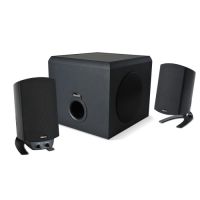Bowers & Wilkins DB3D subwoofer
The DB3D is the smallest in B&W's premium DB series of subwoofers. It's neat, compact and – with its near-£2,000 price tag – not in any way entry-level. And despite its dimensions, of a roughly 12in cube sitting atop a 2in aluminium-trimmed plinth, it weighs a monstrous 25kg, courtesy of the enormous magnets for its two 8in drivers and a super-heavyweight MDF cabinet. In mass density alone, the DB3D ought to have its own gravitational field.
The drivers are B&W's Aerofoil cones with their appealing weave design, set up opposing each other in a sealed cabinet with internal pressure-aiding damping. The sub's 1,000W amplifier is a bespoke B&W design using Class D Hypex modules fitted neatly into the base plinth. Cooling fins run along the bottom, so spikes will be essential on carpeted floors.
B&W caters for quite a few installations though, supplying spikes, silicon domes and tall rubber feet. They screw into a large nut on the metal base panel, which feels a lot more substantial than traditional threaded MDF inserts. That level of exceptional build quality runs throughout the DB3D. From the polished piano-lacquer to the trim, feet and solidly constructed connection panel, fit and finish is probably without equal at the price.
Getting Hooked
Connections span stereo phono and XLR inputs, any one of which will handle an LFE signal. For a smart install, there's a pair of 12V trigger sockets and an RS232 serial connector.
On the connection panel's missing list are speaker-level inputs and any controls. The latter are found on B&W's DB Subwoofers app, which connects your smart device to the DB3D via Bluetooth.
In this app you will find setup, placement and settings guides and independent controls for phono and XLR input. These cover stereo/LFE operation, input gain, crossover frequency, four-position phase and a 12dB/24dB filter slope option. You can set up with any of B&W's own speakers from a drop-down menu or use the built-in EQ settings for Music, Movie and Flat, plus a Custom mode with adjustable parametric EQ across five bands from 20Hz to 80Hz. In terms of physical placement, make sure the DB3D doesn't have one of its drivers pushed close to a wall (so facing sideways if positioned within the LCR stage), and you're good to go. And

